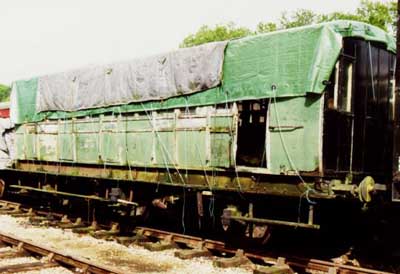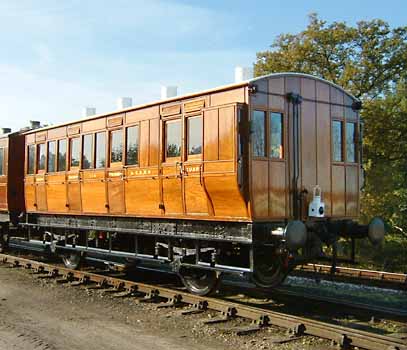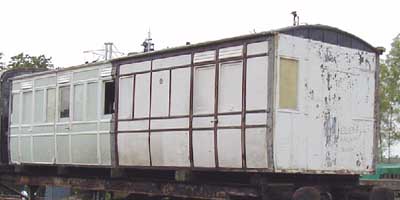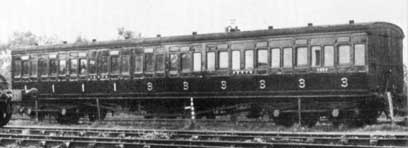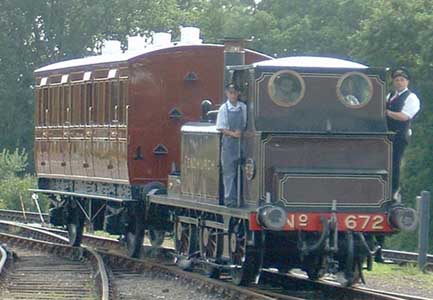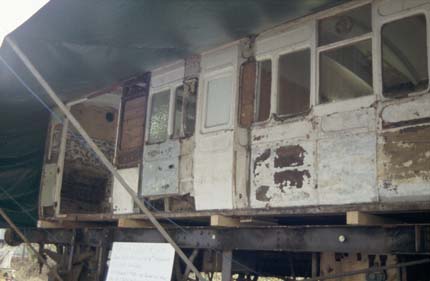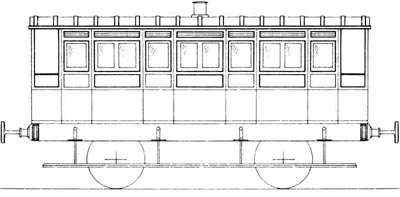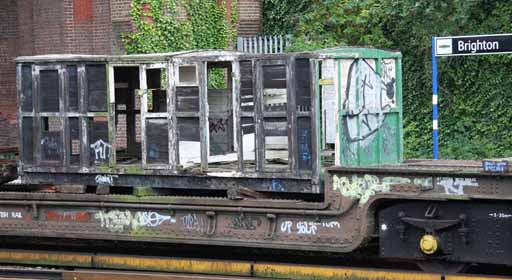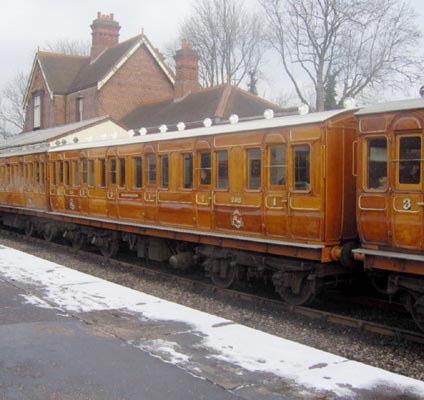

|


|

|
|
Carriage & Wagon Dept - Stock Lists: Carriages, Vans, Wagons & Multiple Units - C&W News SR Coach Group - Goods Division - Operation Undercover - Technical - Join us 

Carriage Fleet Review - 1Victorian CoachesThis is the first in a series of articles surveying the Bluebell Railway's carriage fleet, which originally appeared in Bluebell News a decade ago. The opportunity has been taken to bring their histories up to date, and to try to indicate the future which lies ahead of them. This article deals with our 19th century coaches, excepting the GNR Directors' Saloon, which will be covered later, and the SER Gilbert Car, which is included with the Pullmans. London Chatham and Dover Railway six-wheel brake No 48.
London Chatham and Dover Railway four-wheel brake 3rd No 114.
Restoration commenced in 1998, and it returned to service in November 2006. Further details of the overhaul are available here.
The following details have been provided by David Gould of East Grinstead: Further research, through the South Eastern Society, has revealed that it was withdrawn initially in 1921, but re-instated for hop-pickers specials until 1925.
The department's long-term strategy is that it should eventually form part of an LCDR set of coaches to be used with the P-class tank locos, so further grounded bodies are being collected to further this aim. It has been decided to present the coach to its 1891-99 condition as a brake 3rd, since it will not be "as new", and 2nd-class branding may confuse our passengers, who currently face a choice between first and third, which is also how the tickets are printed.
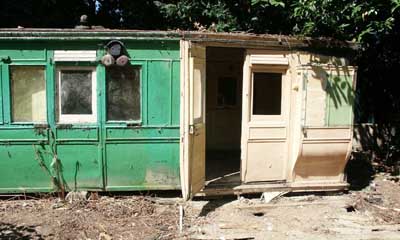 London Chatham and Dover Railway four-wheel brake 2nd No 51.
London Chatham and Dover Railway four-wheel brake 2nd No 51.
As with 114 above, this carriage was built as a brake 2nd in 1889, and soon downgraded to brake third. After withdrawal, like many other such carriage bodies, it was sold, without its underframe, for use as a domestic dwelling in Ashington, Sussex. It was offered to the Bluebell when no longer required by its owner, and recovered during August and September 2003 by a team of volunteers. It retains the unusual LCDR pattern of guard's ducket (lookout) at the end on one side. A suitable underframe is available, and will have to be modified in a similar way to that used for other 4-wheelers, by cutting a section out of the end, and re-positioning the wheels, brake-gear and internal structure.
The coach is now stored under a tarpaulin at Horsted Keynes, sitting temporarily on the same underframe which previously supported its near-identical No.114 (see above). One possibility for the long term is that it might be used as a wheel-chair accessible carriage, creating one large compartment from the brake and adjoining comartment.
London Chatham and Dover Railway six-wheel third No 668.
It was then sold, without its underframe, for use as a domestic dwelling in Yarcombe, Devon, where it remained, lived in, until the death of its owner. Its new owners made the body available to the Bluebell, where it arrived in 2005. As originally built as a full third, the vehicle is of great interest to the Bluebell, since our aim is to reconstruct a train of LCDR vehicles, and non-brake coaches are in short supply. It thus, potentially has a high priority for overhaul, to join Brake 3rd 114 on our train of Victorian 4-wheelers. Although built as a 6 wheeler, it may be more practical to restore it using a 4-wheel underframe, and indeed some coaches of this design were converted to 4-wheelers later in their life for use on the Isle of Wight.
The coach is stored under a tarpaulin at Horsted Keynes, sitting temporarily on the underframe of former SR Bulleid coach 4035.
South Eastern Railway / Southern Railway third No 1050 (5546)
South Eastern Railway Drawing Room Car No 33 This vehicle, built in 1891 by the Gilbert Car Company, was later rebuilt as Pullman Car "Constance", and so is included with the other Pullmans.
London Brighton and South Coast Railway Stroudley coach No 661
It is the first of what we plan as a complete train of Stroudley carriages to run with the Stroudley Terriers, Stepney and Fenchurch.
London Brighton and South Coast Railway Stroudley Brake Thirds Nos 676 and 949
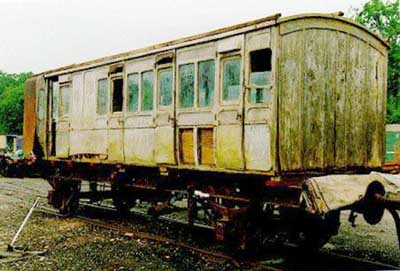
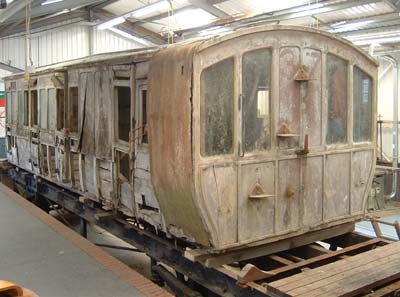
In 2004, work started on No.949, which has been completely dismantled, to enable the bottom sides and ends to be replaced. Much of the timbers from the rest of the body are re-usable. The shortened van underframe was completed in 2005, and the body is now being reconstructed on it. Details of its overhaul are here.
London Brighton and South Coast Railway Stroudley Full Thirds Nos.328 and 992
In 2008 a volunteer team started to shorten the underframe of a Southern Railway van, to take the body of 328.
London, Brighton & South Coast Railway No.35 - Second Class Carriage
Withdrawn at a "census", the chances are that it had been out of use for some time before the official withdrawal date. It survived for over a century after withdrawal in a garden in East Chiltington, Sussex, before being dismantled and put into safe storage on the Bluebell. The body, essentially complete, retains sufficient original internal and external features to enable an accurate reconstruction of its original condition to take place, and replacements for the missing external ironwork have already been made. It will form an interesting complement to our train of Stroudley coaches.
More information is available on the web page for this coach.
London, Brighton & South Coast Railway No.94, Full Brake carriage
The main issue for the future with this vehicle and No.35 is whether the surviving historic material should be conserved (and possibly displayed in a museum environment) or restored to as-built, possibly operational, condition, with the loss of so much original material. One solution might be the retention of the original, and construction of a replica, but this is not an issue we need to tackle just at present, since the restoration of either of these vehicles is not yet being considered.
More information is available on the web page for this coach.
Metropolitan Railway Bogie Stock The restoration of the Ashbury stock, also known as the Chesham Set from its use between 1940 and 1960 on the Chesham branch, has been well documented in Bluebell News and on the web site. It is, however, worth stating some of the factual history of this stock, since many publications, from our own stock book to reference books on preserved carriages, have errors when dealing with these coaches. The coach numbers, builders and dates given here combine evidence found during the restoration with details from an article in Bluebell News in 1966 which was researched from original Metropolitan Railway documents. 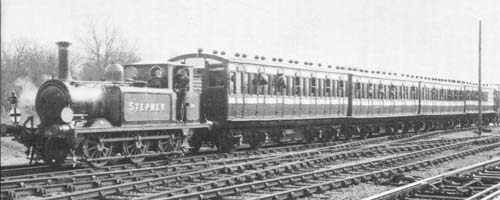 Stepney with the four coaches at Horsted Keynes in the 1960s
The restoration is to the varnished and lined teak-finish of the Metropolitan Railway as carried in the twenties, involving the replacement of all the plywood and metal panels which have been applied over the years. Work on the interiors involves their reconstruction after the ravages of wear and tear, and dry and wet rot. The running gear is receiving particular attention, probably its first major overhaul in more than fifty years. The first two vehicles re-entered service at the start of 1999, No.368 in May 2002, and the overhaul of the other composite was completed in 2006. The complete set won the HRA C&W award for 2006/7.
The second article in this series covers pre-grouping coaches from the period 1901-1923. See also the BASH project pages which describe the restoration of the Metropolitan Railway Ashbury stock in more detail.


Return to BRPS Home Page, to the Timetable or to Special Events Carriages & Wagons - Intro - Development - Stock Lists: Carriages, Vans, Wagons & Multiple Units - Carriage Fleet Review - Join us C&W Works News - SR Coach Group - Goods Division - Operation Undercover - Carriage Shop - Technical Pages Visitor Info. - Museum - Trust - Catering - Contacts - What's New - Projects - Locos - Carriages & Wagons - Signals - History - Other - Links - Search - FAQ Why not become a BRPS Member? - Get more involved as a Volunteer Last update 25 March 2009 by Richard Salmon. © Copyright BRPS. Privacy Policy |
